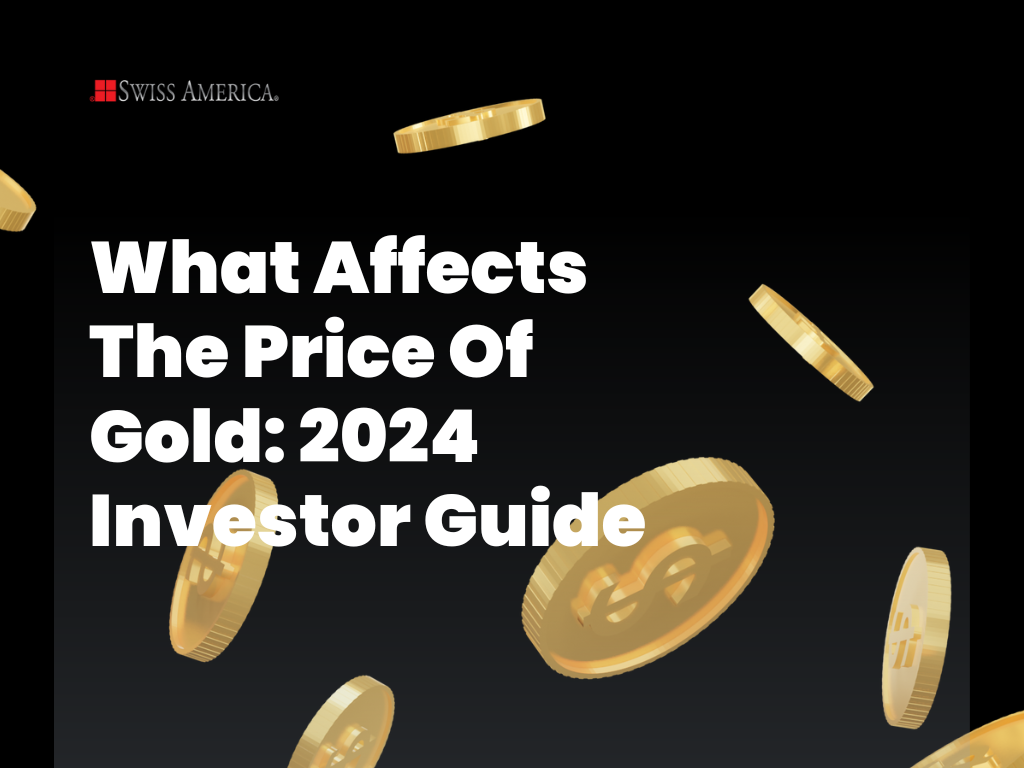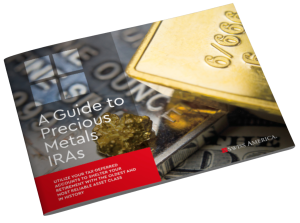
What affects the price of gold? Simply put, when uncertainty looms, people turn to gold for security. In this article, we’ll explore the key factors driving gold prices and how they work together.
Investors buy gold during times of economic uncertainty. Take Covid-19. In August of that year, gold reached an all-time high of over $2,070 per ounce. And now, in 2024, it’s up over 30%, with 77% of Americans worried about the economy, alongside concerns over the Russia-Ukraine war and conflicts in the Middle East.
Gold prices represent investor’s sentiment about global events. This article explains what affects gold prices and how to leverage this knowledge for investment decisions.
Supply and demand
The easy explanation for why gold prices go up and down is supply and demand. People and companies buy gold for jewelry, electronics and investments. But investment demand is the driver with the most ups and downs.
Demand for gold
Right now, there’s a ton of demand coming from each country’s treasury to hold gold in reserves. In 2024, central banks bought more gold than ever.
Think about it, why does the US Treasury have 8000 tons of gold when the Federal Reserve Note is our current form of currency? Shouldn’t they hold dollars in reserve? And what practical purpose do they use it for? They don’t manufacture and sell jewelry, electronics, etc., so these are not the reasons why they have it or why it has value.
Historically, many countries keep U.S. dollars as savings. But because the dollar’s value changes, other countries seek ways to protect their funds. Some countries worry about U.S. debt and world tensions affecting it’s value. So, they’re buying gold instead as a way to protect their savings.
Gold gives central banks a lot of power to perform financial gymnastics in emergency situations.
The chart below from the World Gold Council shows central bank’s plans for increasing gold holdings in the next 12 months:

Gold supply
There’s only so much gold in the world. And while mining brings new gold to market, it isn’t easy or cheap. As easily accessible gold becomes scarce, mining companies need to dig deeper to reach reserves. This adds complexity and expense to mining operations.
Market trends
There’s several trends right now that drive up the price of gold. It’s everything from economic uncertainty to the rising U.S. national debt to wars and sanctions globally. It seems like every time you turn around, there’s bad news.
That’s why Goldman Sachs is bullish on gold through 2025 and recently shared:
“Gold is our strategists’ preferred near-term long (the commodity they most expect to go up in the short term), and it’s also their preferred hedge against geopolitical and financial risks.”
Economic indicators
So what does Goldman Sachs or Citi see in our economy as the reason for continued interest in gold?
Inflation rate
When inflation erodes the purchasing power of fiat currencies, people turn to gold as a way to preserve their capital.
People see gold as a reliable hedge against inflation because it holds its value when currencies lose purchasing power.
Expectations about future inflation also matter. Investors who think inflation will rise might buy gold early, increasing demand before inflation even hits. In this way, gold can act as both a safety net and a proactive investment.
Interest rates
Investors see gold as a safe-haven low risk type of asset.
When we have low interest rates, people buy more gold because they see it as a better investment than other safe assets like bonds or savings accounts. The opposite is true when we have higher interest rates since they can “park” their money in a high-yield savings account.
Currency value
This is a hot topic right now because the U.S. national debt is now larger than our annual Gross Domestic Product. The pandemic increased government spending by over 50%. This caused inflation which also devalued the purchasing power of the dollar.
If we continue to print paper money in this manner, it continues to erode the value of the U.S. dollar. This is why investors look to gold so that they can hold on to a tangible asset that is not tied to U.S. currency.
Market sentiment and economic uncertainty
Whenever investors worry about the unknown, they turn to gold.
Safe haven status
Gold has reputation as a safe haven asset because it’s very independent of other investments. It’s not tied to currency. It doesn’t rely on someone else to complete their obligations. And, it tends to move differently than the stock market.
So, when investors need safety, they buy gold. For example, during the COVID-19 pandemic, economic uncertainty and market swings pushed gold prices to a record high of over $2,000 per ounce in August 2020. No one knew what would happen and there was definitely a lot of uncertainty.
Long-term investment considerations
The best way to hold gold is for the long-term. You can try to time the market but gold isn’t really meant to be a speculative asset. It’s an “insurance policy” to protect your wealth.
That’s why many investors use gold as a way to diversify their portfolio. It helps to balance out the ups and downs of the stock market or other assets. And ultimately, this reduces your risk.
Monetary policy and central bank actions
What central banks do greatly impacts gold prices through their decisions on interest rates and economic forecasts.
Federal Reserve and central banks
As we mentioned above, when interest rates are higher, investors may not buy as much gold. Decisions by the Federal Reserve create a ripple effect for either increased or decreased interest in gold as an investment.
Central banks’ economic forecasts also influence investor behavior. If the forecast predicts slow growth or economic trouble, people often buy gold as a safe option. But, if there’s a positive outlook, investors might go for assets with higher potential returns instead.
Gold reserves and sales
Central banks hold gold as part of their reserves, and their decisions to buy or sell can affect market prices. When they buy more gold, they show confidence in its value. That increases prices. If they sell large amounts, it increases supply and can lower prices.
In August 2024, global central banks added 8 tonnes of gold to their reserves, which was less than earlier in the year and below the 12-month average of 33 tonnes. Emerging market banks like Turkey and Poland, were the biggest buyers of gold.
Historical and current trends
Looking at past and recent trends can help you decide if gold is right for your portfolio.
Past year trends
Gold prices in 2023 and 2024 have been driven by inflation, interest rates, and global events. As inflation rose and central banks adjusted policies, more people bought gold. So far, prices climbed from $2,063 per ounce in January to nearly $2,743 by late October which is a 33% increase just in 2024.
In 2023, gold’s average price was $1,943, which was a 13% increase from the year before. By late 2024, the average reached $2,363, up 28% from 2023. These trends show how that people have concerns about current trends and continue to hold gold.
Gold today
Today, gold prices continue grow because of geopolitical tensions, economic data, and central bank policies. Ongoing conflicts like in Middle East, have boosted gold’s appeal as a safe-haven investment.
Economic reports, like inflation data, and the possibility of lower interest rates from the Federal Reserve have also made gold more appealing since lower rates reduce the cost of holding assets that don’t earn interest.
Why gold investors choose Swiss America
For investors seeking a safe way to purchase gold, silver, or other precious metals, it’s important to work with a reputable dealer like Swiss America. With over four decades of experience, Swiss America has supported thousands of satisfied customers with their physical precious metal investments.
Here’s what you can expect if you partner with us:
What influences gold price
As we’ve discussed, multiple factors influence gold prices. It’s not just inflation. Or interest rates. Or the stock market. All of these dynamics may change and can cause a chain of events that lead people to buy more gold.
You never know what can happen. That’s why holding gold is an insurance policy for your savings that can give you protection from various potential threats.
To learn more about investing in gold or other precious metals, connect with the Swiss America team today!
What affects the price of gold: FAQs
Who determines the price of gold?
Global supply and demand in the market determine the price of gold. Major financial institutions, gold traders, and international exchanges like the London Bullion Market Association (LBMA) help set the gold price through daily trading activities.
Who controls the price of gold?
No single entity controls the price of gold. Market demand, central bank policies, interest rates, inflation, and economic conditions drive gold prices.
How does gold get its value?
Gold gets its value from its rarity, durability, and universal recognition as a store of wealth. Its historical role as currency and its demand in industries like jewelry and technology also contribute to its lasting appeal.
Note: The information in this post is for informational purposes only and should not be considered tax or legal advice. Please consult with your own tax professionals before making any decisions or taking action based on this information.
